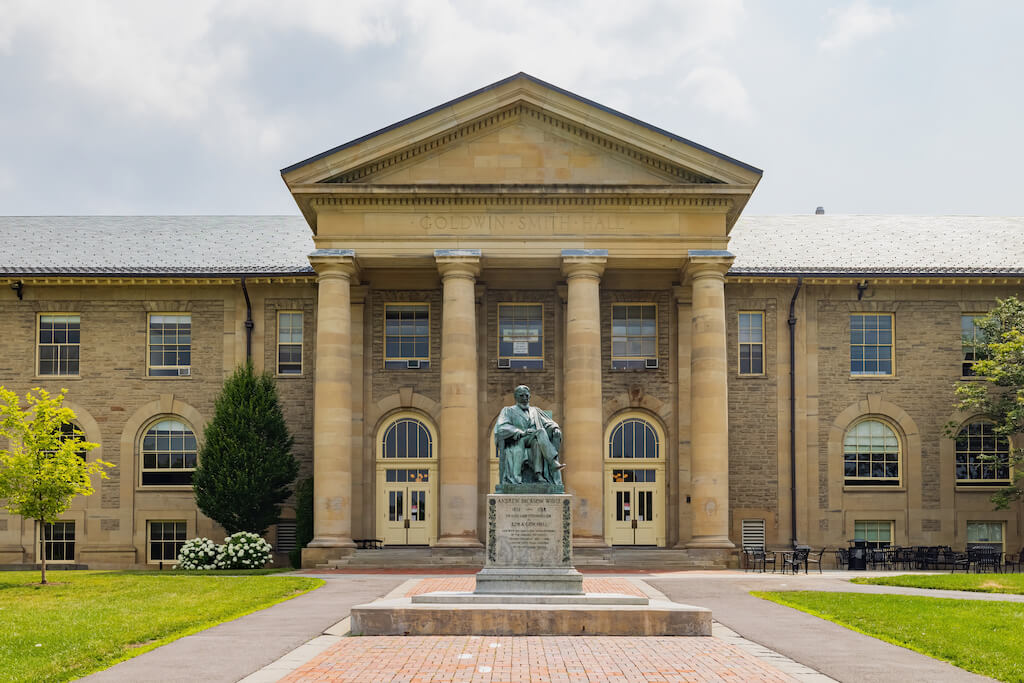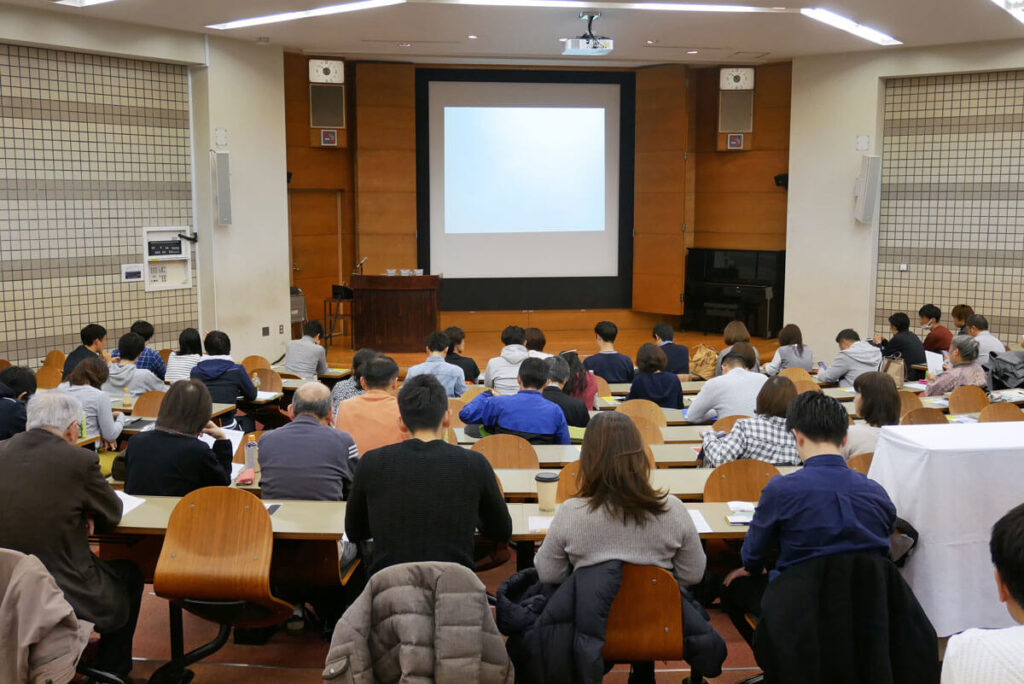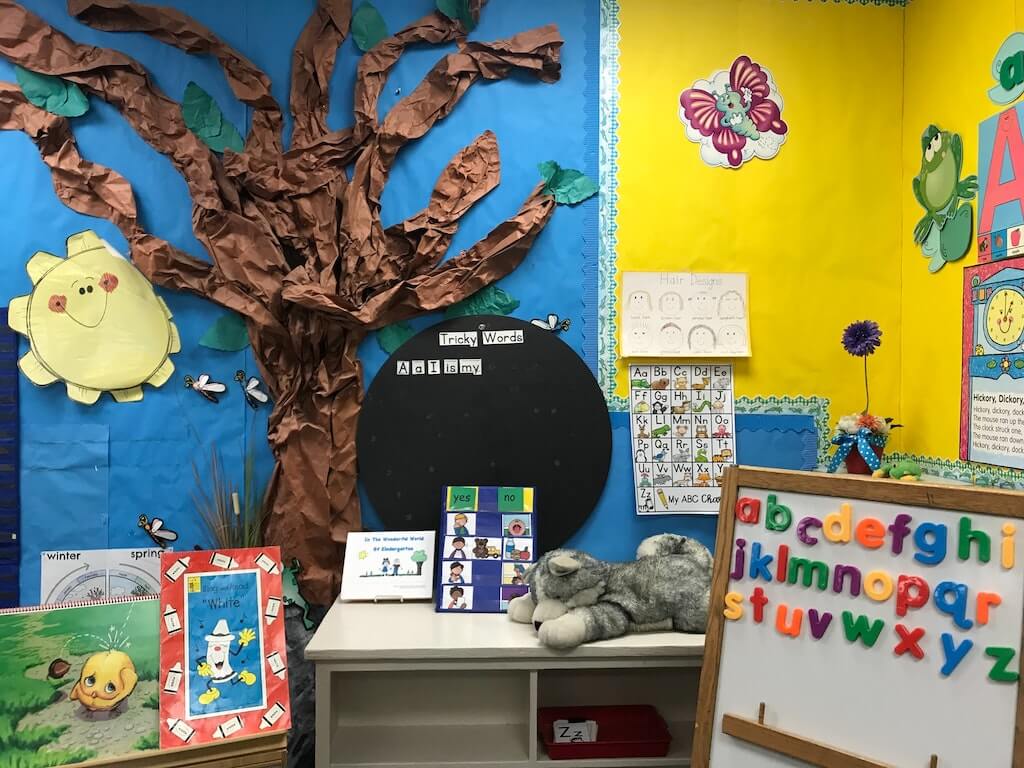I use an AI-related tool daily. Last October, I wrote about NotebookLM, Google’s personalized AI collaborator. In that article, I described my activities of loading links to previously published blog articles and creating audio files, aka podcasts. There were a few “hiccups,” but I enjoyed the audio output.
Recently, I read that Google added more features to NotebookLM. Using an article of mine about a speech that I had given at the 2024 Education Finance Council Annual Meeting titled The Evolution of U.S. Higher Education: The Influence of Technology & Its Ability to Surmount and Create Future Challenges as a primary source, I opened a new notebook.
At the end of my original article, I wrote that I added approximately 1,000 words in adapting the script of my speech to a blog article. My explanation was that bullet points in a PowerPoint slide presentation are easier to talk about than to write about. While my article did not include the original slides, some of the charts were reproduced.
I knew that NotebookLM does not include a discussion of charts when the source is an online link. Because of this, I was surprised when the audio overview of my article ended up being 26 minutes plus. When I listened to it, I was even more surprised.
NotebookLM’s Audio Overview
The first time I used the audio feature, I was impressed with the speech quality and pronunciation of each of the two AI-generated discussants. The same voices, one male and one female, are used in the current version. I thought I would tire of them over time, but their spirited conversation and sometimes humorous context are friendly and relatable.
The length of the article I originally published was approximately 7,300 words. According to the word to speech converter that I use, it would take more than 56 minutes to deliver the text of the article as a speech at an average rate of 130 words per minute. Slowing to a 100 word per minute rate, it would take 73 minutes. My original delivery was around 75 minutes.
The audio overview is 26 minutes, and the pace of the conversational discussion between the two voices appears to be closer to the 100 word per minute pace than higher. The AI eliminated approximately 60 percent of the content from my article. I felt like they captured most of my key points. Depending on which AI voice expressed a point, the other appeared to understand the context and importance of that point,
Without going through the slides from my original slide deck and specific paragraphs from the blog article, it appears that the biggest “miss” from the text-to-audio translation was that the AI eliminated my conclusion at the end of the speech regarding which colleges and universities would “survive” and which would “thrive.” Another indicator that context is important with AI.
NotebookLM’s Briefing Document
One of NotebookLM’s features is that it allows you to create a briefing document. Before I created the briefing document, I decided to load the PDF version of my original PowerPoint slides. After adding the PDF file as a source, I asked the software to create a briefing document. I appended it below.
I kept the briefing document in the Arial font generated by NotebookLM to distinguish it from my content. I reviewed it. It synthesized a 7,300-word document into a 1,600-word document. The synthesis for this tool was not aligned with the audio overview.
One example where the two tools differed in their analysis of the source documents was the discussion and briefing summary of the National Defense Education Act in 1958. The audio overview highlighted the fact mentioned in my text and slides that to get the Act through Congress, the Senate agreed to the House’s preference of providing low-interest loans instead of grants. A comment was made that student financial aid may have been vastly different if it had been the other way around. The briefing document does not mention the discussion at all.
The briefing document includes my conclusion at the end of the speech/article regarding which institutions will survive and/or thrive. As mentioned earlier, the audio overview left that out of the content overview.
Briefing Document: The Evolution of Higher Education and the Impact of Technology
Sources: Excerpts from “EFC Keynote_Wally Boston_Mar2024_FINAL2.pdf” and “Higher Education Evolution: Past, Present, & Future – Wally Boston” by Dr. Wallace E. Boston.
Date: October 26, 2023 (based on the latest date mentioned in the sources)
Prepared for: Interested Parties in Higher Education, Finance, and Technology
Executive Summary:
Dr. Wallace E. Boston’s keynote and related blog post provide a comprehensive historical overview of higher education in the United States, emphasizing the profound influence of technology and its role in both surmounting past challenges and creating new ones. The documents trace the evolution of higher education from its colonial roots through landmark legislation like the Morrill Act and the GI Bill, highlighting key periods of growth and transformation. A significant portion focuses on the impact of technology, particularly the rise of online education and, most recently, the disruptive potential of Artificial Intelligence (AI). The analysis concludes with observations on which types of higher education institutions are likely to survive and thrive in this evolving landscape and identifies emerging trends and companies to watch. The overarching theme is the increasing need for adaptability and innovation in the face of technological advancements and shifting workforce demands.
Main Themes and Important Ideas/Facts:
- Historical Evolution of US Higher Education:
- Early Years (Pre-1862): Colleges were primarily private, often religiously affiliated, and catered to a limited population of wealthy individuals. The ten oldest operating colleges in America are listed, starting with Harvard (1636).
- The Morrill Act (1862 & 1890): This landmark legislation provided federal lands and later funding to states to establish public colleges focused on “the agricultural and mechanical arts,” significantly expanding access to higher education for previously excluded populations, including farmers and, through the Second Morrill Act, African Americans.
- “The Act provided states with federal lands…that could be sold to raise money or used to establish public colleges. The act opened opportunities for an education to thousands of farmers and people previously excluded from higher education.”
- Growth in the 20th Century (1900-1940): The number of institutions and student enrollment increased significantly, but completion rates and the percentage of Americans with degrees remained relatively low.
- The GI Bill (1944): This act provided substantial financial support for WWII veterans, dramatically increasing college enrollment and the number of awarded degrees.
- “Provided WWII veterans with funds for job training, college education, unemployment insurance, and housing…Within 7 years, 8M vets received education benefits including 2.3M for college. Degrees awarded doubled between 1940 and 1950.”
- Congress estimated that income tax increases more than repaid the $14B expended.
- National Defense Education Act (1958): Spurred by Sputnik, this act established the legitimacy of federal funding for student loans and expanded college resources.
- “Established legitimacy of federal funding of student loans…Made substantial funds available for low-interest student loans.”
- Higher Education Act (HEA) (1965): This act, a successor to the NDEA, authorized comprehensive financial aid programs, including grants, loans, and work-study.
- “Title IV of the Act authorized financial aid to students including grants, loans, work-study, and rules for financial aid need analysis.”
- Title IX (1972): Prohibited sex discrimination in federally funded education programs, most notably impacting college sports.
- “Prohibited sex discrimination in any program or activity at institutions receiving federal financial aid.”
- Tuition Inflation and Discounting (1978 onwards): Harvard’s significant tuition increase in 1978 set a trend among elite institutions, leading non-elite privates to adopt tuition discounting strategies to attract students. Economist David Breneman’s 1994 book highlighted this trend.
- “The escalation of tuition by elite privates would also lead to a practice by non-elite privates known as tuition discounting.”
- Small colleges artificially inflated their tuition (list price) and granted “merit” scholarships designed to yield a targeted enrollment.
- The Influence of Technology on Higher Education:
- The Rise of Online Education (Late 20th Century onwards): The installation of fiber optic cables and the launch of the first fully online universities (University of Phoenix in 1989, Jones International University in 1996) marked a significant shift. The Sloan Consortium was formed to study online learning.
- “The University of Phoenix began offering the first fully online degree.”
- “Jones International University opens as the first fully online university.”
- Increased Online Enrollment: By Fall 2019, over 7.4 million students took at least one online class, and over 3.4 million were exclusively online.
- Disruptive Potential of Online Models (Christensen et al., 2011): Traditional universities’ business models were deemed unsustainable, while online models optimized student flow and offered potential for more affordable, quality education.
- “‘What the theory of disruptive innovation suggests is that the business model of many traditional colleges and universities is broken.'”
- “‘This emerging disruption…offers an opportunity to answer the challenge posed…to redefine the meaning of quality in higher education and make a quality education fundamentally affordable.'”
- The Advent of Artificial Intelligence (2022-2024): The introduction of ChatGPT and the proliferation of AI tools across various applications are poised to revolutionize higher education and the workforce.
- “I am in the camp that says AI changes everything, like fundamentally changes society, the nature of the workforce, the information economy, all of it. If that is true, then universities have to change dramatically as well.” (Paul LeBlanc, SNHU President)
- Hundreds of AI tools are now available for text, video, images, research, design, presentations, audio, productivity, and code generation.
- AI’s Potential in Higher Education: Deep learning offers “five new superpowers” including hyper-personalized instruction, adaptivity, expanded access, immediate feedback, and redefined assessment. However, concerns exist regarding bias, loss of human element, privacy, and over-reliance on testing.
- Shifting Workforce Demands and the Value of a Degree:
- The Global Auction for Jobs (Brown, Lauder & Ashton, 2010): Increased global supply of college-educated workers, technology standardization, and the rise of high-skill, low-wage workers in emerging economies have intensified competition.
- “Market value of American workers is part of a global auction for jobs.”
- The “Opportunity Trap” occurs when a bachelor’s degree becomes a prerequisite without guaranteeing an advantage.
- The College Devaluation Crisis (Wingard, 2022): The efficacy of a college degree as a guarantee of value peaked around 2010 and is being challenged.
- “The efficacy of a college degree as a guarantee of value hit its peak in 2010.”
- By 2030, a college degree may be replaced as the primary pathway for career success.
- Focus on Skills and Competencies: There is a growing emphasis on skills-based hiring and the need for individuals to demonstrate what they can do with their knowledge.
- “Professionals will be judged less by what they know than what they can do with what they know.”
- Rise of Alternative Credentials and Learning Records (LERs): Initiatives like the Credential Engine and SkillsFWD aim to create transparent systems for recognizing diverse credentials and skills.
- The Credential Engine tracks over 1 million credentials in the US.
- SkillsFWD is funding projects focused on the adoption and accessibility of Learning and Employment Records.
- Growth of Apprenticeships: The National Apprenticeship Act of 2023 aims to significantly expand apprenticeship programs, strengthening connections between education and workforce needs.
- “Goal – 1 million new programs over next 5 years” for apprenticeships.
- Financial Challenges and Regulatory Landscape:
- State Funding Cuts: Public universities faced significant funding reductions after the 2008 recession, leading to increased tuition and other cost-saving measures.
- “Overall funding for two- and four-year colleges was $6.6B below what it was prior to the 2008 recession.”
- Tuition Discounting: This practice continues to set new records, indicating financial pressures on many institutions.
- Biden Administration’s Focus: The current administration has focused on student loan forgiveness and regulating third-party providers, with less emphasis on innovation and cost-cutting. There are concerns about attempts to hinder the growth of online education.
- “Recent Department of Education initiatives appear to be designed to reign back the growth in online education, the probable best hope for lowering the overall cost of a degree.”
- Future of Higher Education: Survivors and Thrivers:
- Institutions Likely to Survive: Elite institutions, public flagships (especially in states with budget flexibility and growing populations), large online institutions, community colleges with online excellence and employer partnerships, and alternative education providers with strong employer ties.
- Institutions Likely to Thrive: Large online universities (if not overly regulated), alternative education providers aligned with major employers (like Google, AWS, Accenture), and elite institutions and public flagships in wealthy states.
- AI-Related EdTech Companies to Watch: A list of companies (e.g., Acadeum, Catalyte, Gobekli) developing solutions to improve retention, learning outcomes, student engagement, and reduce costs.
Quotes:
- “You have to know the past to understand the present.” – Carl Sagan (cited by Dr. Boston)
- “The agricultural and mechanical arts.” – Description of the focus of colleges created under the Morrill Act.
- “Administrative bloat.” – Term used to describe increased institutional costs due to faculty focus on research and growth in administration.
- “Tuition discounting continues to set new records.” – Highlighting the ongoing financial strategy and its implications.
- “AI changes everything, like fundamentally changes society, the nature of the workforce, the information economy, all of it. If that is true, then universities have to change dramatically as well.” – Paul LeBlanc on the transformative impact of AI.
Conclusion:
The provided sources paint a picture of a higher education landscape undergoing rapid and fundamental transformation. While historical context reveals periods of significant growth and adaptation driven by legislation and societal needs, the current era is characterized by the disruptive force of technology, particularly AI, and evolving demands from the workforce. The traditional model of higher education faces increasing pressure regarding cost, value, and relevance. Institutions that embrace innovation, adapt to technological advancements, and forge strong connections with employers are best positioned to survive and thrive in the years to come. The rise of alternative credentials and the focus on demonstrable skills suggest a future where the traditional four-year degree may no longer be the sole determinant of career success.
NotebookLM’s Mind Map
One of NotebookLM’s new features is a Mind map-generating tool. After creating the audio overview and the briefing document, I created a Mind Map. My purpose was to see what the output looked like and if it provided any clues about why the audio overview and briefing document were different.
The overview image of the Mind Map is appended below. There are five summary blocks. These do not align in name to the five areas of the briefing document.
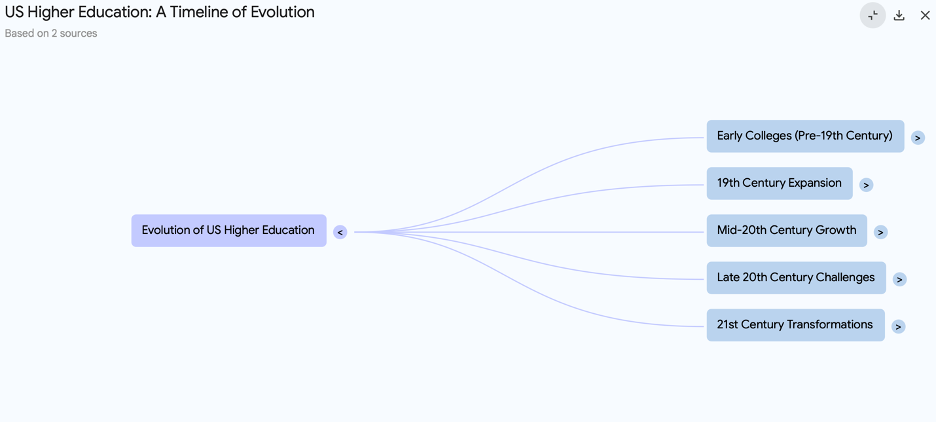
The Early Colleges block was expanded into the image appended below. While the detailed blocks listed are accurately summarized from the article and the slides, I’m not sure this was the appropriate block if blocks were limited to five. My intent of using this slide in my speech was as an ice-breaker for the audience, asking if anyone had attended these 10 oldest colleges.
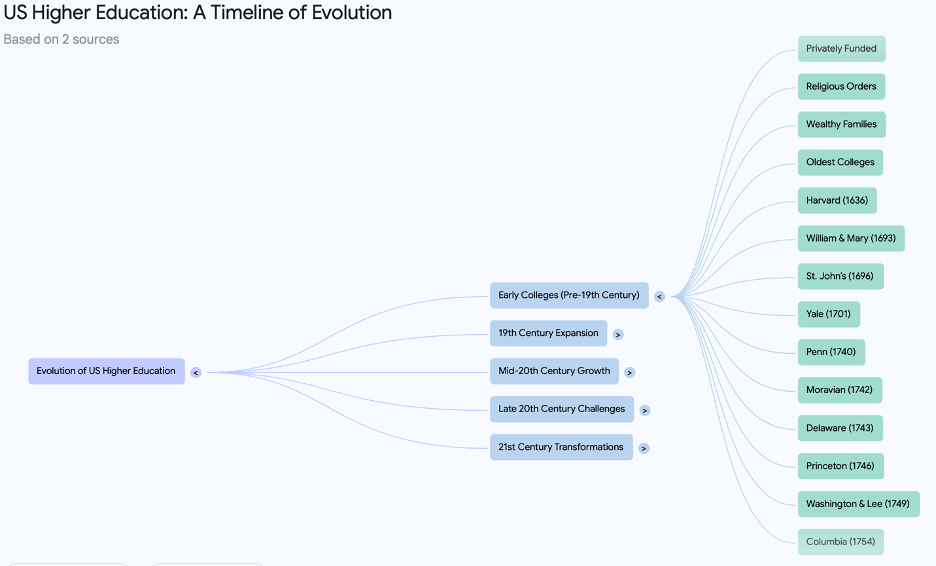
Unlike the first block, the second block, representing 19th-century expansion had two lower-level blocks, each with subblocks. I expanded those blocks as well and appended a screenshot of the image below. Again, I’m not sure I would have used 19th-century expansion as a second block. I also don’t believe that all the end blocks are the best blocks to summarize the larger blocks.
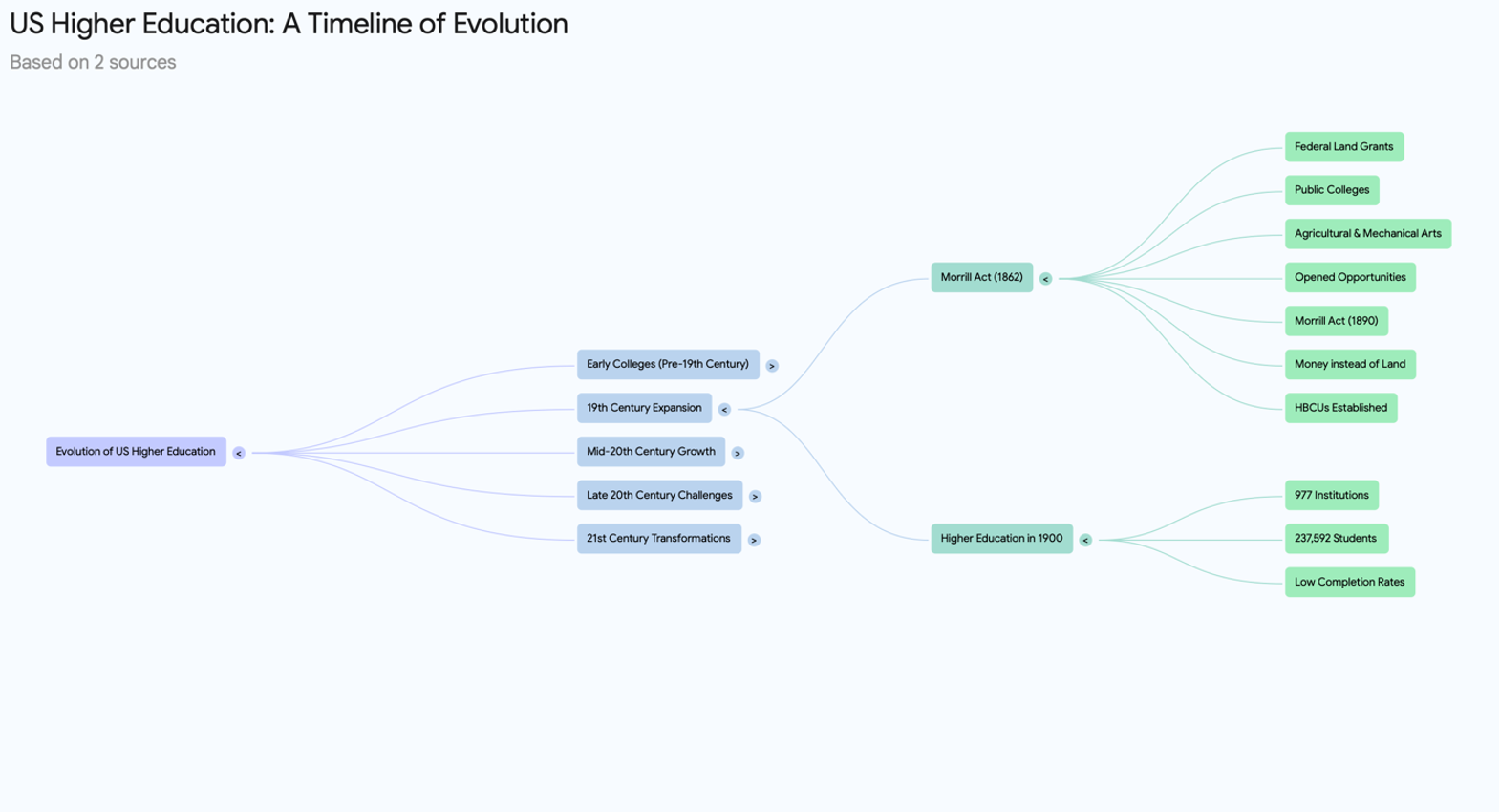
The third major block, mid-20th-century growth, had the most blocks so far in the Mind Map. The image of the expanded map is appended below. I don’t think the 1940 block, setting the stage with the number of institutions and students enrolled in college, has the same weight as the four subsequent blocks related to legislation.
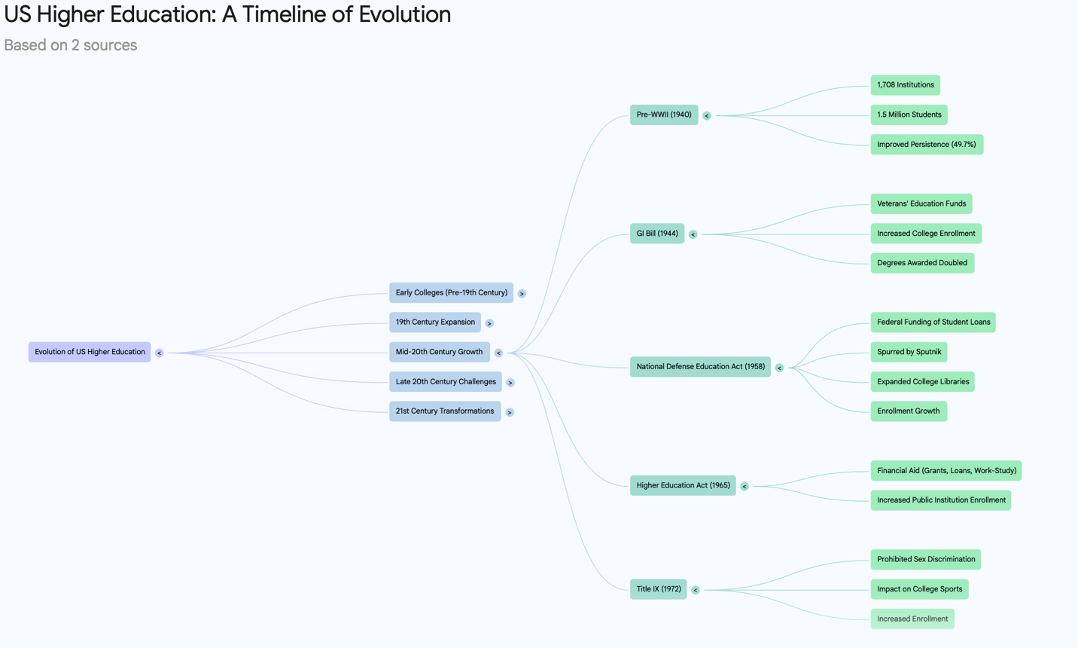
The fourth block of the top-side Mind Map was expanded like the previous three and is appended below. By the time I expanded this section of the map, I realized that the usefulness of this is as a tool itself, and not necessarily the specific blocks and subblocks.
After all, those items can be changed if you were creating a map like this on your own. If anything, the generation of these maps by the tools makes me optimistic that humans will have a vital role in the review of most content generated by Gen AI tools.
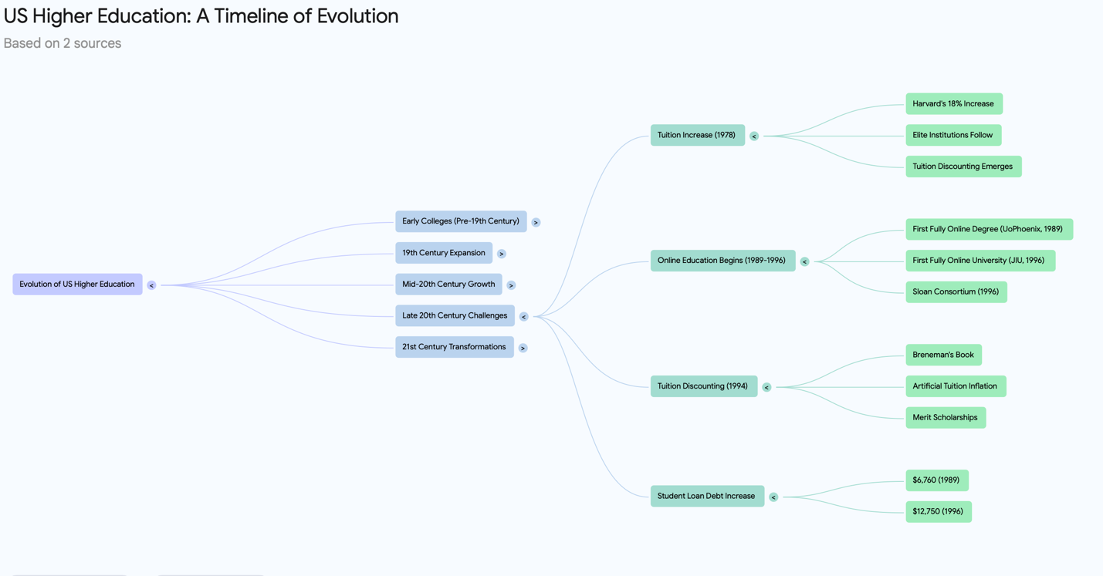
It’s the revelation from the expansion of the fifth block of the Mind Map that illustrates how the logic of the AI is different from the intent of the original author (me). I’ve appended the first stage of block five’s expansion below. Because there are so many categories, I had to limit the expansion of the items because a screenshot condensed to capture all of them would be too small to read.
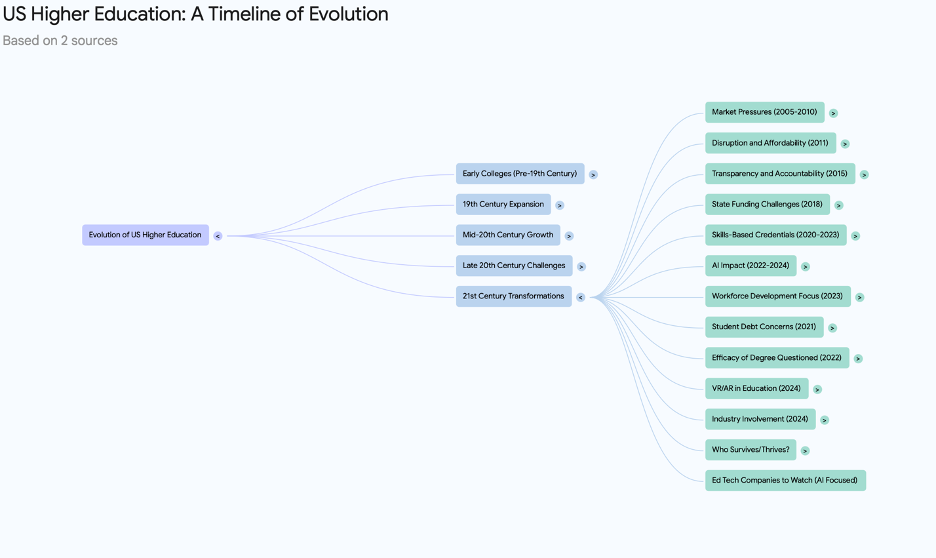
I split the fourth-level blocks into three images. The first image, appended below, encompasses the first four blocks of the third level.
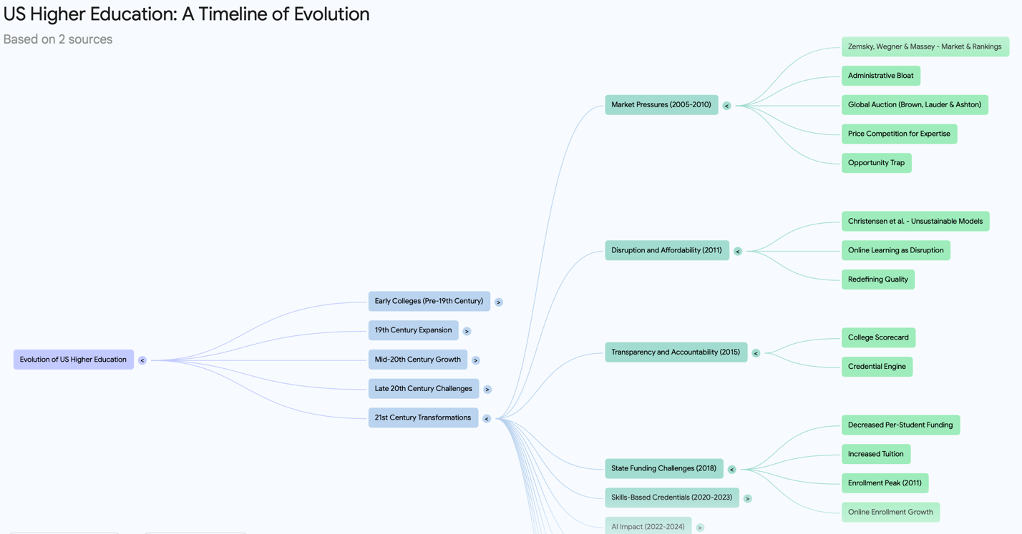
The next four third-level blocks are expanded and included in the second image appended below. Once again, I’m not sure that these would have been my choices, but the image forms the basis for a great thinking and discussion exercise.

The last third-level blocks are expanded and included in the third image appended below. My comments are the same as those from the previous two images.
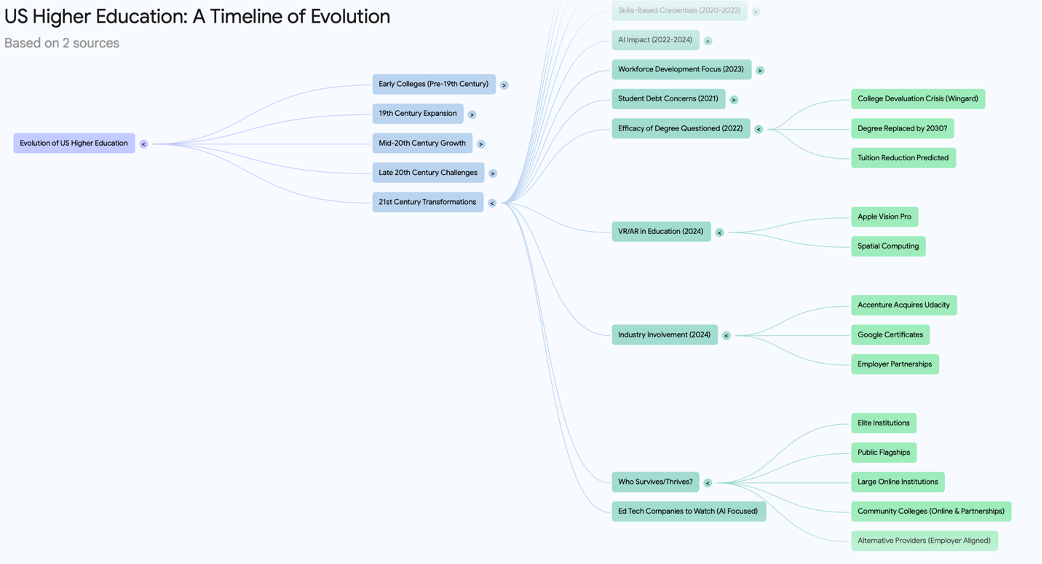
Other NotebookLM Features
There are several other features that NotebookLM offers that I did not highlight here.
- Timeline—A timeline feature organizes the source materials in a chronological timeline. In the case of this 380-year “history,” there were a lot of dates. I thought the timeline that I generated was too inclusive. There were many dates and events listed. At the same time, all of these were sourced from my original speech/blog post.
- Study Guide – A list of 15 questions, including five categorized as essay questions, were created along with an answer key. While this source (my blog article) was not intended to be assigned in class, the study guide option is a great tool for students. I liked eight of the first ten questions. I thought that two of them were too vague to generate targeted answers. Four of the five essay questions were good. The fifth was okay, but I would have attempted to reduce the scope of the question.
- FAQ – An FAQ tool generated five essay-type questions and provided a detailed narrative response for each. I liked it.
Final Thoughts
NotebookLM allows the user to load up to 20 sources for every notebook. If I wanted to expand my usage of the tool for this original source (thinking I might want to write a book), I could have loaded 18 more sources that I used to compile my speech. Those 18 sources would have been included in the data to generate the output for the tools discussed.
Perhaps the output would have been different. I don’t know, but I hope it won’t be substantially different since my speech/article was a synthesis of all the sources I would consider adding to the notebook.
If Google considers suggestions from NotebookLM users, I ask that some consideration be made for creating an alignment between the various tools. Perhaps that could occur at a future date. Nonetheless, the tool’s value would increase if the audio overview, briefing document, mind map, FAQs, Study Guide, etc., were aligned better.
Lastly, I am amazed at the audio overview generated. I did not attempt to compare its output to the source, but it appears to me that other sources of items mentioned (like the Higher Education Act – HEA) were utilized to enhance the conversation.
Perhaps I’ll find a source that will provide me with a deeper understanding of the algorithms used to construct the audio conversation. Regardless, given the popularity of podcasts, I would consider using this tool to create podcasts for several of my blog articles.





